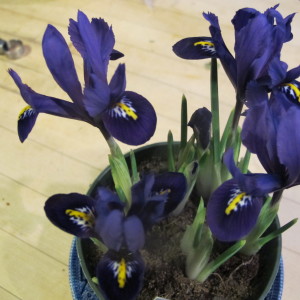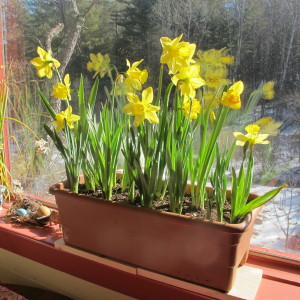Potted Bulb Plants
As we amble toward spring I find I crave blossoms more and more. This must delight the people who sell flowers, as I have a hard time walking by a display of iris or daffodils growing in pots without buying some. But buying grocery store potted bulb-flowers is not just an indulgence. Many can be kept alive until the ground thaws and planted. Others are less durable. Let’s take a look.
I love those little purple iris that are commonly sold in 4-inch pots. I bought some recently for $3.99 and although they only lasted a week, I was delighted to have them. This particular iris is known to botanists by its Latin name, Iris reticulata. It’s related to Siberian iris and bearded iris, but has different growing needs.
According to the tag that came with the iris, you can plant these outdoors “in part shade after last spring frost.” What they don’t tell you is that Iris reticulata require very good drainage. They originated in the mountains of western Asia where they grow wild on pumice slopes of extinct volcanoes.
If you want these fabulous little iris to succeed for you, do not plant them in a heavy clay soil. In fact, build a six-inch raised bed of sandy soil and grit with very little organic matter. Outline your planting bed with stones or bricks. You should be able to pour water from your watering can over the bed and not have any pooling. Planting on a hillside will help with drainage, too. Most of my soil is too rich for Iris reticulata, so I’ve not had good luck with them after the first year. I guess this year I’ll build them their own little bed.
Tete-a-tete daffodils are great little bundles of yellow joy that are common in grocery stores and at flower shows. Each bulb produces more than one mini daffodil. They are very cold hardy and can be planted outdoors when the soil has thawed. Just keep them watered indoors after blooming. Like other small bulbs, plant the tips just 2 inches beneath the soil surface.
Every year I force paper whites. Also in the daffodil family, these are not usually planted in soil indoors, but in a container filled with pebbles. Choose one that has no holes and arrange the paper whites bulbs among the stones. Later, when the leaves and stems are tall, they will tip over unless you arrange your stones so that they hold the bulbs in place. I add water until it just kisses the bottom of the bulbs. Roots emerge and soon thereafter green leaves and flower buds emerge. Each bulb should produce more than one blossom.
The paper white flowers are usually – though not always – highly fragrant. Some people do not like the scent, though I do. And even after the flowers have dried out they still look good to me for quite a while. The unfortunate part about paperwhites is that they are not viable in our climate outdoors. No, do not save them and plant outdoors. They will not come back for you next year.
I also potted bulbs for forcing that I put in my cold basement last November, and I have brought them up into the light and warmth of the house. This year I used a plastic container called an “Earth Box” for planting. The one I used is 22 inches long, 9 inches wide and has a planting space about 7 inches deep; I planted about 20 bulbs in it. It is a “self-watering container” that has a water holding compartment a couple of inches deep.
Self-watering containers are all the rage for growing flowers on decks and doorsteps. They prevent the dehydration (and death) that old fashioned flower pots allowed. They wick up water from the water reservoir so that you only have to water once a week or so, depending on the weather. But they are great as containers for bulbs, too, because they don’t leak water out onto your table or windowsill unless you dump gallons of water and make them overflow.
Tulips are some of my favorite flowers but are also loved by deer, chipmunks, voles (but never moles), red squirrels, gray squirrels and a variety of other rodents. The bulbs are even edible by humans – some Dutch ate them to avoid starvation in WWII. So most years I plant some in pots and force them to bloom indoors. Just enjoy them now.
My personal experience is that tulips bloom well their first year –indoors or out – but fewer and fewer bloom each year thereafter. So if you buy potted tulips at the florist shop or nursery, I don’t think they are worth babying along until summer and planting outdoors in May.
I planted 100 tulips in a big raised bed in my vegetable garden last fall. I planted a few garlic cloves in with them in an effort to discourage rodents, though that is no sure cure. In the past deer have not bothered my tulips, but if I am feeling paranoid or see lots of footprints near the tulip bed, I could surround it with a chicken wire fence. Since the bed is only 8 feet by 3 feet, even a 4-foot fence should keep out the deer, I believe. I will use the tulips as cut flowers.
So brighten your house with some flowers grown from bulbs. Most you’ll be able to plant outdoors for another show next year, albeit later.
Henry may be reached by e-mail at henry.homeyer@comcast.net or at P.O. Box 364, Cornish Flat, NH 03746. Please include a stamped envelope if you wish a response by mail.




